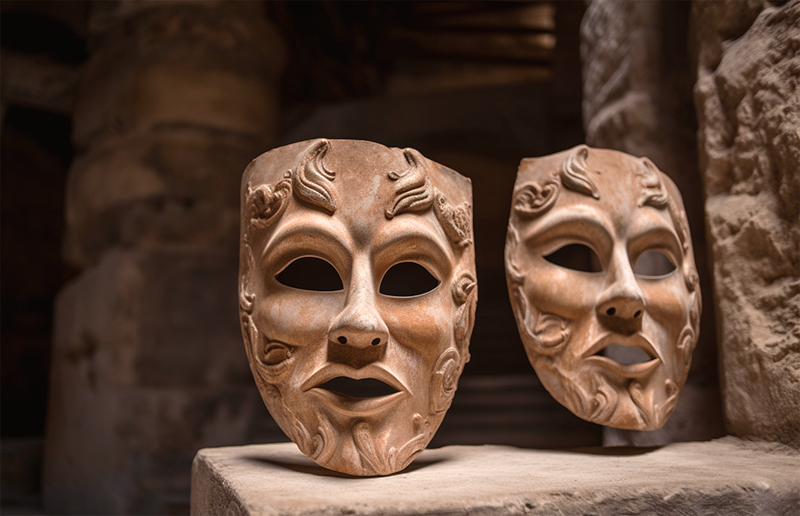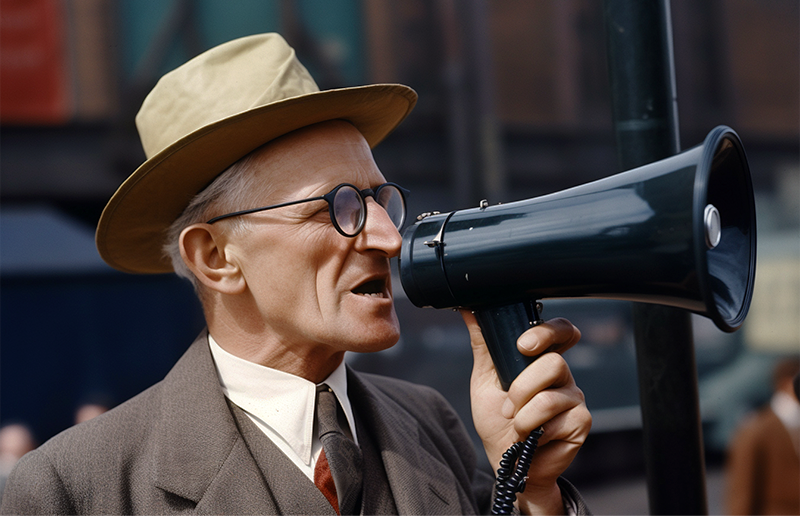Voice changers have been a part of human history for centuries, serving different purposes from entertainment to security. And while we may know which direction we’re heading in with voice changers, like our AI voices, and other advancements, we think it’s a good time to take a look at where it all began.
In this article, we will journey through the untold history of voice changers, examining their origins, development, and lasting impact on communication. So, sit back and get ready for an auditory adventure that is sure to enlighten and entertain.
The ancient Greeks were among the first to experiment with voice manipulation through the use of masks in their theatrical performances. These carefully crafted masks not only conveyed the emotions and personalities of the characters but also served as acoustic devices, amplifying and modifying the actors’ voices. This early form of voice changing allowed actors to take on multiple roles and create a more immersive experience for the audience.

Ventriloquism, the art of projecting one’s voice to create the illusion of another speaking entity, has roots dating back to ancient Egypt. Priests used this skill to create the illusion of speaking statues, inspiring awe and reverence among the worshippers. The ancient Egyptians’ ability to manipulate their voices contributed to the development of voice changers and their eventual incorporation into various facets of society.
As the world moved into the early modern period, inventors developed new tools to manipulate the human voice. Megaphones, the simple yet effective cone-shaped devices, allowed individuals to amplify their voices for public speaking or commanding troops on the battlefield. The acoustic mask, a more advanced creation, not only amplified the wearer’s voice but also altered its timbre, providing an early example of the transformative power of voice changers.

In the 19th century, voice changers like the speaking trumpet and stethophone gained popularity. The speaking trumpet was a brass instrument used by fire chiefs and military leaders to project their voices over great distances, while the stethophone, a precursor to the modern stethoscope, enabled doctors to hear patients’ heartbeats and breath sounds. These devices demonstrated the growing versatility of voice-changing technology in various fields.
The vocoder, invented in the 1930s by Bell Labs engineer Homer Dudley, revolutionized voice changing by encoding speech for secure communications. During World War II, this groundbreaking technology played a crucial role in encrypting sensitive conversations between leaders like Winston Churchill and Franklin D. Roosevelt. The vocoder’s use in secure communications laid the groundwork for future developments in voice-changing technology.
The ring modulator, an electronic device invented in the 1930s, became a popular tool for creating futuristic, otherworldly sounds in science fiction films and TV shows. By blending two audio signals, the ring modulator produced a unique, robotic-sounding voice, perfect for bringing alien characters to life. This innovative device expanded the creative possibilities for voice changers in entertainment and contributed to their growing popularity.
As computers became more powerful and accessible, software developers created computer-based voice changers that could digitally manipulate audio signals in real-time. These programs offered users unprecedented control over their voices, allowing them to alter pitch, timbre, and even create entirely new sounds. The advent of computer-based voice changers marked a new era of creativity and customization in voice manipulation.
The rise of smartphones and portable devices brought voice-changing technology to the masses. With a wide range of apps and devices available, users could easily experiment with voice manipulation for fun or practical purposes. This widespread accessibility further cemented the role of voice changers in modern communication and entertainment.
Voice changers have left an indelible mark on the music industry, with artists from The Beatles to Daft Punk harnessing their transformative power. The Beatles famously used the ADT (Automatic Double Tracking) technique to create rich, layered vocals, while Daft Punk incorporated vocoders and synthesizers to craft their iconic robotic sound. These innovative uses of voice manipulation technology have shaped the musical landscape, inspiring generations of artists to push the boundaries of sonic expression.
In the realm of film and television, voice changers have enabled actors and voice artists to bring a wide array of characters to life. From the menacing, altered tones of Darth Vader in Star Wars to the lovable, helium-infused voice of Alvin from Alvin and the Chipmunks, voice manipulation has been crucial in creating memorable and distinct characters. The creative application of voice-changing technology in film and television has not only captivated audiences but also expanded the possibilities for storytelling and character development.
💡Speaking of these characters, be sure to check out these articles on how to do a Darth Vader voice and how to do a chipmunk voice using our real-time voice changer. 💡
Voice changers are important for anonymous communication, as they help protect individuals’ privacy by disguising their voice and avoiding personal identification. Voice changers are useful for individuals who want to express opinions or share information without fear of retribution. They provide a layer of protection, ensuring that messages are heard and individuals are not targeted. Overall, voice changers are a valuable tool for anyone who wishes to communicate anonymously, allowing them to share their thoughts and ideas without fear of being identified or persecuted.
Speaking of privacy, check out our article on voice deepfakes, what you need to know about them, and how a voice changer can help protect your identity online.
From ancient theatres to modern technology, voice changers have played a massive role in shaping the way we communicate, entertain, and protect ourselves. As technology continues to advance, voice changers will undoubtedly evolve, offering new possibilities for personal expression, security, and accessibility. Go ahead and enjoy all the benefits that this new tech offers by using Voicemod’s real-time voice changer and soundboard on all your favorite communication apps and gaming platforms.